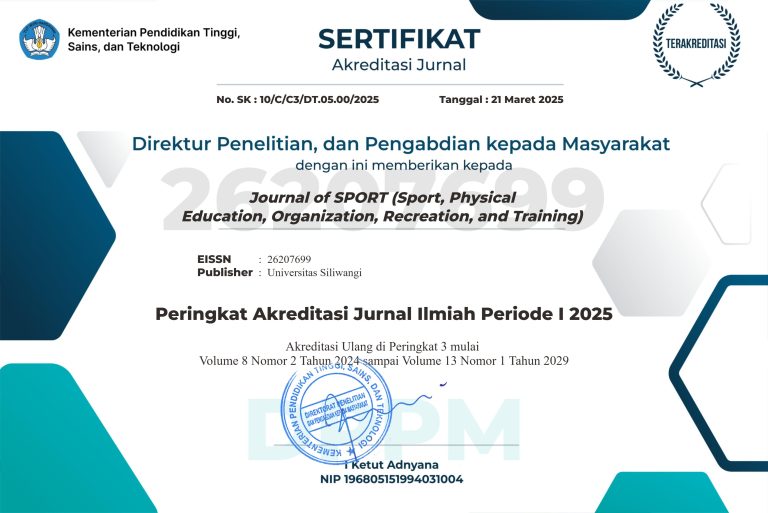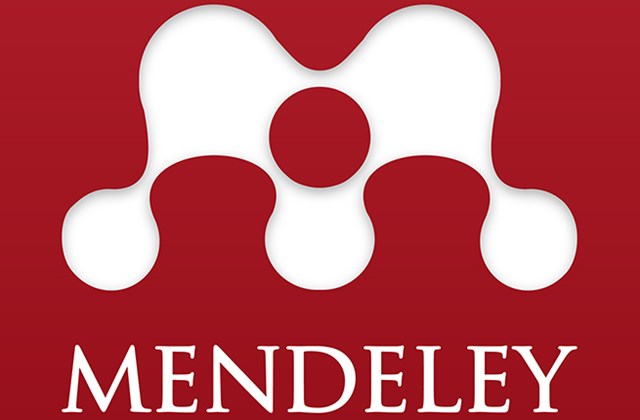Integrasi Model Latihan Pencak Silat berbasis Olympic Movement
Abstrak
Dinamika krisis pendidikan nilai muncul ketika banyak atlet hanya fokus pada kemenangan tanpa memperhatikan nilai-nilai olimpiade. Pergeseran paradigma dari hasil olahraga "sport outcomes" menjadi hasil pembangunan sosial "development societal outcomes" merupakan hal mendasar dalam perubahan cara kita memahami nilai olahraga. Hal ini mengakui potensi olahraga untuk berkontribusi terhadap pembangunan sosial yang lebih luas dan meningkatkan kualitas hidup masyarakat. Kajian ini menawarkan arah baru dengan mengintegrasikan model latihan pencak silat berbasis olympic movement, sehingga pesilat/atlet memahami nilai-nilai olimpiade secara luas dan komprehensif. Penelitian ini menggunakan metode eksperimen dengan jumlah sampel sebanyak 30 orang, meliputi kelompok model pencak silat berbasis olympic movement dan 15 kelompok kontrol. Instrumen yang digunakan adalah Olympic Movement Instrument (OMI). Hasil penelitian menunjukkan bahwa tingkat pengaruh terhadap nilai-nilai olimpiade meningkat secara signifikan, kelompok latihan pencak silat yang mengikuti olympic movement menunjukkan hasil yang lebih baik dibandingkan kelompok kontrol. Disimpulkan bahwa model pencak silat berbasis olympic movement yang memuat nilai-nilai respect, friendship dan excellence dengan struktur yang disengaja efektif memberikan kontribusi terhadap pemahaman olympic movement antar pesilat/atlet. Model ini didasarkan pada olympic movement yang cocok digunakan dan efektif dalam membentuk karakter pesilat.
Kata Kunci
Teks Lengkap:
PDFReferensi
Astle, D. E., Bathelt, J., & Holmes, J. (2019). Remapping the cognitive and neural profiles of children who struggle at school. Developmental Science, 22(1), e12747. https://doi.org/10.1111/desc.12747
Bean, C., & Forneris, T. (2016a). Examining the Importance of Intentionally Structuring the Youth Sport Context to Facilitate Positive Youth Development. 3200(June), 0–16. https://doi.org/10.1080/10413200.2016.1164764
Bean, C., & Forneris, T. (2016b). Is Life Skill Development a By-Product of Sport Participation ? Perceptions of Youth Sport Coaches. 3200(September). https://doi.org/10.1080/10413200.2016.1231723
Bean, C., & Forneris, T. (2017). Is Life Skill Development a By-Product of Sport Participation? Perceptions of Youth Sport Coaches. Journal of Applied Sport Psychology, 29(2), 234–250. https://doi.org/10.1080/10413200.2016.1231723
Bean, C., Kramers, S., & Harlow, M. (2022). Exploring life skills transfer processes in youth hockey and volleyball. International Journal of Sport and Exercise Psychology, 20(1), 263–282. https://doi.org/10.1080/1612197X.2020.1819369
Fraenkel, Jack R., Wallen, N. E. (2009). How to Design and Evaluate Research in Education. In McGraw-Hill Higher Education (Issue 0).
Fraenkel, Jack R., Wallen, N. E. (2022). How to Design and Evaluate Research in Education. In McGraw-Hill Higher Education (11th ed.). https://www.libgen.is/book/index.php?md5=BF7C0575E403691A9E8C8654BD9717FD
Ha, J. P., Lee, K., & Ok, G. (2015). From Development of Sport to Development through Sport: A Paradigm Shift for Sport Development in South Korea. International Journal of the History of Sport, 32(10), 1262–1278. https://doi.org/10.1080/09523367.2015.1062756
Jeki Purnama Putra, Nurlan Kusmaidi, Mulyana, & Amung Ma’mun. (2023). Coaching and Development of Pencak Silat Sports Based on Living Respect Values in Positive Youth Development. Kinestetik : Jurnal Ilmiah Pendidikan Jasmani, 7(3), 566–576. https://doi.org/10.33369/jk.v7i3.29716
Kendellen, K., Camiré, M., Bean, C. N., Forneris, T., & Thompson, J. (2017a). Integrating life skills into Golf Canada’s youth programs: Insights into a successful research to practice partnership. Journal of Sport Psychology in Action, 8(1), 34–46. https://doi.org/10.1080/21520704.2016.1205699
Kendellen, K., Camiré, M., Bean, C. N., Forneris, T., & Thompson, J. (2017b). Integrating life skills into Golf Canada’s youth programs: Insights into a successful research to practice partnership. Journal of Sport Psychology in Action, 8(1), 34–46. https://doi.org/10.1080/21520704.2016.1205699
Kidd, B. (2008). A new social movement: Sport for development and peace. In Sport in Society (Vol. 11, Issue 4, pp. 370–380). https://doi.org/10.1080/17430430802019268
Koenigstorfer, J., & Preuss, H. (2018). Perceived Values in relation to the Olympic Games: development and use of the Olympic Value Scale. European Sport Management Quarterly, 18(5), 607–632. https://doi.org/10.1080/16184742.2018.1446995
Ma’mun, A. (2019). Governmental Roles in Indonesian Sport Policy: From Past to Present. International Journal of the History of Sport, 36(4–5), 388–406. https://doi.org/10.1080/09523367.2019.1618837
Peres, F. de F., de Melo, V. A., & Knijnik, J. (2016). Olympics, media and politics: The first Olympic ideas in Brazilian society during the late nineteenth and early twentieth centuries. International Journal of the History of Sport, 33(12), 1380–1394. https://doi.org/10.1080/09523367.2016.1275578
Putra, J. P., Kusmaedi, N., Mulyana, M., & Ma’mun, A. (2023). Effect of Limb Power, Arm Power, Hand Eye Coordination on the Combination of Punches and Kicks of Martial Arts Athletes. Month, 3(1). https://doi.org/10.53863/mor.v0i00
Siljak, V., & Djurovic, D. (2017). Historical development of the olympic movement. Sport Mont, 15(3), 43–46. https://doi.org/10.26773/smj.2017.10.008
Sin, T. H., & Ihsan, N. (2020). The effectiveness of Pencak Silat to change teenage personalities. Jurnal Konseling Dan Pendidikan, 8(1). https://doi.org/10.29210/139800
Somphong, S., Kutintara, I., & Rattamanee, K. (2019). The impact of the Thailand Olympic Academy on the Olympic Movement in Thailand. African Journal of Hospitality, Tourism and Leisure, https://doi.org/10.29219/139800
Subekti, N., Sistiasih, V. S., Syaukani, A. A., & Fatoni, M. (2020). Kicking ability in pencak silat, reviewed from eye-foot coordination, speed, and ratio of limb length-body height. Journal of Human Sport and Exercise, 15(Proc2), 453–461. https://doi.org/10.14198/jhse.2020.15.Proc2.36
Syaifullah, R., & Doewes, R. I. (2020). Pencak silat talent test development. International Journal of Human Movement and Sports Sciences, 8(6), 361–368. https://doi.org/10.13189/saj.2020.080607
Widyastuti, C., & Dimyati. (2019). Comparison of Psychological Skills Between Pencak Silat and Karate. Ido Movement for Culture, 19(3), 50–55. https://doi.org/10.14589/ido.19.3.6
DOI: https://doi.org/10.37058/sport.v8i2.12147
Refbacks
- Saat ini tidak ada refbacks.
##submission.copyrightStatement##
Journal of SPORT (Sport, Physical Education, Organization, Recreation, and Training)
Program Studi Pendidikan Jasmani
Fakultas Keguruan dan Ilmu Pendidikan
Universitas Siliwangi
Jl. Siliwangi No. 24 Kota Tasikmalaya - 46115
email: penjas@unsil.ac.id
e-ISSN: 2620-7699 ; p-ISSN: 2541-7126

This work is licensed under a Creative Commons Attribution-ShareAlike 4.0 International License.
INDEX BY
1.png)












